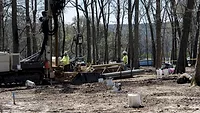Concrete Pads: The Unsung Heroes of Monitoring Wells
The Drilling is Good, but How Is Your Well Completion Game?

Sure, you can install a monitoring well, but do you put a cape on that superhero when you finish?
Source: NAVFAC
So you’re the real deal when it comes to drilling? You can drill through everything and install a perfect monitoring well. But what is your well completion game like? Sure drilling holes is one thing, but being a top-notch driller means you’ve got to excel at creating a sturdy concrete pad.
Let’s talk about something that might seem as tough as the boots on your feet, but trust me, it’s got a soft spot in making monitoring wells work like a charm. We’re diving into the world of concrete pads – those sturdy slabs around the monitoring well that don’t just look good but do a whole lot more than you’d think.
Alright, picture this: You’re out there setting up a monitoring well, helping the consultants get all the info they need about what’s cooking under the ground. You’ve got your PVC screen and casing – that tough pipe that’s like the shell of the well. But here’s the kicker: If you don’t have a solid concrete pad around it, you set the stage for real problems.
Let’s break it down. The concrete pad acts as the first line of defense, the shield that stands between your well and the wild world around it. If it’s not done right, you’re practically inviting dirt, rain and all sorts of funky stuff to crash the well’s party. Trust me, you don’t want those gatecrashers messing up the data consultants and your clients rely on.
Now, let’s talk about the nitty-gritty. That concrete pad isn’t just there for show – it’s got serious jobs to do:
- Rock-solid stability: Think of it as the foundation of your well’s world. A properly done pad keeps your well steady and strong, no matter what Mother Nature throws at it. When you’re client collects samples or does maintenance, they’re not dancing on shaky ground.
- No more swamp drama: Ever seen a well surrounded by a swampy mess after a downpour? Yeah, that’s what happens when you don’t level off the concrete pad. A well-constructed pad is like a superhero cape for your well – it keeps the area dry and prevents a messy swamp takeover.
- Easy access, big safety: Consultants prefer not to do a tightrope walk when they work on your well. That concrete pad offers a slightly sloped, secure space to get things done. Plus, it’s like a safety net – no tripping, no sliding, just solid ground for a job well done.
If the pad doesn’t do its job, they could deal with surface contamination, changes in water levels, skewed water quality data, a mini marshland, slippery surfaces and potential safety hazards. That’s a recipe for frustration, unreliable data and, most likely, the loss of the monitoring well.
What’s the impact? You might think, “Who cares about the concrete pad? It’s just a slab!” But hold your horses – it’s much more than that. Think about the consultants who rely on accurate data. If your concrete pad isn’t up to snuff, it’s like handing them a cup of coffee with a leaky bottom – messy and disappointing.
Imagine those consultants trying to take samples, run tests and do their expert thing. If the pad doesn’t do its job, they could deal with surface contamination, changes in water levels, skewed water quality data, a mini marshland, slippery surfaces and potential safety hazards. That’s a recipe for frustration, unreliable data and, most likely, the loss of the monitoring well. Not exactly the heroic results they’re after, right?
Here’s the deal: Don’t underestimate the power of a well-made concrete pad around your monitoring well. It’s not just a slab of stone; it’s a backbone, a protector and a game-changer. When you set up that pad, you’re not just making a surface – you’re making a statement to your clients. A statement that says, “I take pride in my work. I know the importance of every detail, even the ones that might seem hidden.”
When you craft that concrete pad, remember you’re not just laying down concrete – you’re laying down the foundation for accurate data, confident consultants and a job well done. It might not be the flashiest part of the well, but it’s darn well one of the most important.
Remember, this isn’t just a job – it’s a legacy you’re leaving behind.
Looking for a reprint of this article?
From high-res PDFs to custom plaques, order your copy today!





